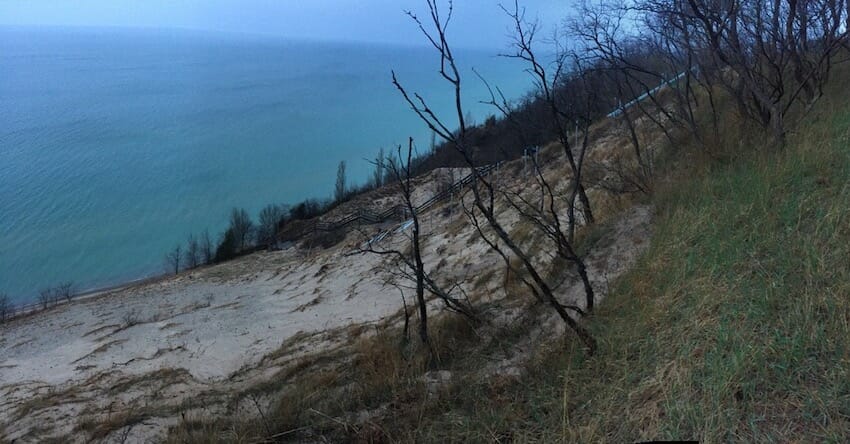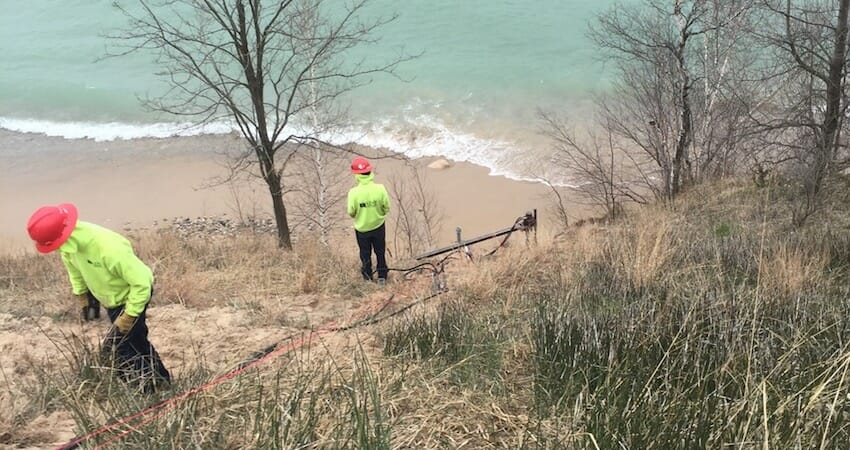Owning Waterfront Property on Lake Michigan
Owning waterfront property on Lake Michigan certainly has its benefits. With the shore located just a few yards aways, it is a dream location for outdoor enthusiasts. Lake Michigan offers everything from fishing and swimming to kayaking and sailing. The views alone are something to behold. Where else can you find a shoreline with such beautiful blue water and rolling sandy dunes?
Those Lake Michigan sand dunes are the largest system of freshwater sand dunes in the world. Many of them rise above the lake surface by several hundred feet. Over 275,000 acres of sand dune formations exist in Lake Michigan. With the combination of waves and wind, sand dunes are naturally formed to protect the surrounding habitat. This climate attracts native plants and animals as well as provides a natural feature that many use for enjoyment.
But there is trouble is in paradise, especially for your beach front property. And it’s all because of those rolling sandy dunes. Sand dunes naturally erode over time. Many have been eroding for years and are quite fragile. Everything from the destruction of natural plant life to the combination of raging winds and churning water adds to the erosion. State legislators have enacted protective measure to stop sand dune erosion over the past 30 years. As a result, many of the sand dune systems in and around Lake Michigan are identified as areas of high risk erosion.
READ MORE Lakefront Foundation Repair in Shelby, Michigan
The Challenges of Waterfront Property in Michigan
With little to no cohesion in the soil and no good bearings, sand does not make for a stable foundation site. One of the biggest problems that beach front properties in Lake Michigan face is creating access to the shoreline. This is especially true for properties that are built in the dunes. Some homeowners have resorted to creating walkways using a variety of materials that lead from the property to the shoreline, but even these can shift in the dunes without a proper foundation. Kent Foundation Repair recently faced this challenge when a homeowner asked for a tram system to be installed on their dune property. Our Kent Companies Helical Pier division took to the challenge and installed the longest tram foundation to date in Ludington.
The solution to working with the unstable soil of sand dunes is helical piers. A helical pier is commonly defined as a steel pipe or shaft with auger-type plates. When turned, the treads of the helical pier go deep into the soil until they are set in the firm and solid strata, deep below the surface layer. The adequate depth for each helical pier is defined by turning torque. Helical piers come in a number of different shapes and sizes. They are designed to provide a precise support capacity for each given situation. While helical piers can be installed using hand power tools, in the case of installation on a sand dune, small mobile units are much more practical.
For most typical construction jobs, helical piers are used as a deep foundation support to vertically hold the load. Once a helical pier has been installed in the soil, it is cut to the proper elevation height. Additionally, with installation near sand dunes, helical piers may need to be screwed into the soil at a downward angle. This creates a tieback force to hold the structure (in this case, a tram system) in place, preventing any shifting or sliding. Helical piers fall under the “deep foundation” category; providing pre-construction underpinning to a foundation. Helical piers can be installed quickly and with no vibration, preventing damage to neighboring structures.
READ MORE Helical Piers for Foundation Repair
Installing the Tram on Lake Michigan Sand Dunes
With the installation of this tram system on the Lake Michigan dunes, the Kent Foundation Repair first had to assess the situation. The sand dune that we were scheduled to work on was 350 feet high. The owners of the Lake Michigan property had used a wooden stair railing to access the beach. That accounts for 266 stairs. Imagine having to lug all your gear and coolers down that many steps! Naturally, we at Kent Foundation Repair were excited about the prospect of adding a convenient and stable solution that would make trips to the shoreline much easier.
Before Kent Foundation Repair could even begin on the project, there was much preparatory work to be done. With the help of All Access Lift LLC, we hauled out several tons of equipment to the property. We had to consider how would would transport all of the needed materials up and down and 350 foot high dune. Part of our equipment entourage was a Bobcat T190 Compact Track Loader, which has an operating weight of 7,775 lbs and can lift up to 1,900 lbs. This allowed Kent Foundation Repair to easily transport and lift all the needed materials, including the tram components and the helical piers around the sand dune site.
As part of the material and installation setup, Kent Foundation Repair transported over fifty helical piers for the tram support. Although we had assistance with moving materials using our equipment, we still faced the challenge of transporting the helical piers and other materials up and down the sand dune by hand. This was possibly our biggest logistical challenge when setting up and constructing the inclined tram foundation.
READ MORE Sand Dune Erosion
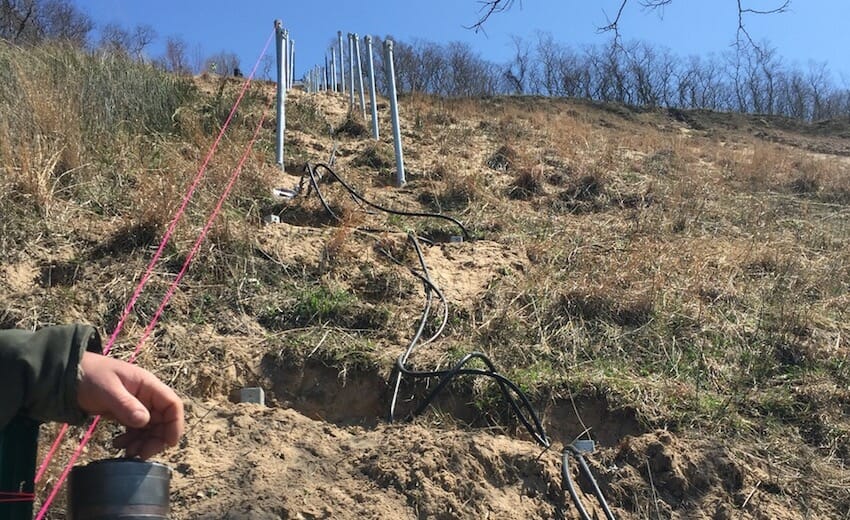
Each of the over 50 helical piers were installed one by one along the side of the dune. There are a few reasons we chose to work with helical piers instead of push piers. Although both push piers and helical piers are end bearing tools, helical piers have the added benefit of providing tension. Steel helical piers feature a square bar or pipe design with helical flight, a post hole digger, and the ability to be hydraulically screwed into the soil, similar to screwing a bolt into a nut. The helix-shaped plates are welded to the steel pipe/square bar, which closely resembles an auger. Push piers cannot be removed once they are inserted into the soil, but helical piers can be screwed back out. Push piers also take longer to install than helicals and helical piers can generally do more than one function.
Helical Piers For Lakefront Foundation Repair
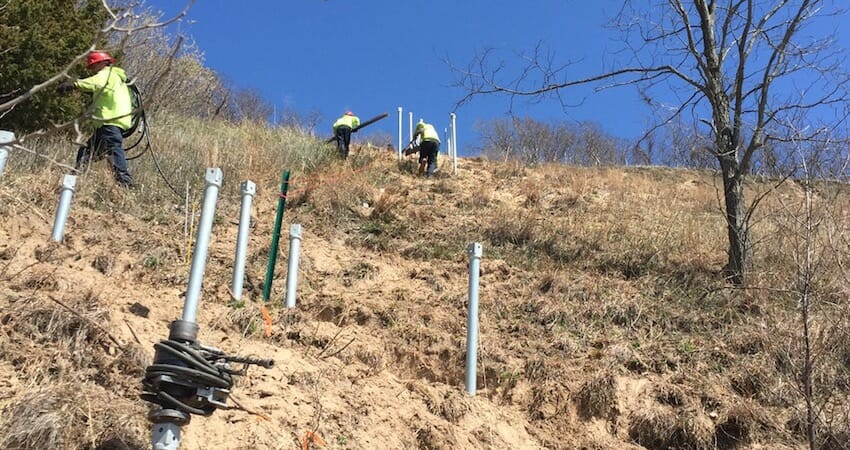
Helical piers are used as a foundation repair tool and provide support to a variety of foundation types. Once installed, they can prevent settling or movement. They are designed to hold, vertically, a load place on them. In this case, they are supporting an inclined tram. Helical piers are considered some of the most versatile and reliable foundation tools and are easy to install. They come in a variety of shapes and sizes, allowing for a variety of helical plate combinations. This allowed us to easily match the unique soil conditions and match load requirements, all with a minimum amount of difficulty.
Once we had the helical piers unloaded and ready to be placed in the ground, we started the installation process. Helical piers are installed using hydraulic pressure. This is an unobtrusive way to install the piers with no loud noises or vibrations. This prevents an unsightly worksite or a costly mess. The hydraulic installation method also allows for tight and accurate placement of the helical piers. This also ensures that all required loads are achieved and that there is enough bearing, without the unnecessary additional material costs.
READ MORE Other Kent Foundation Repair Foundation Repair Jobs
Completing the Lakefront Tram Installation
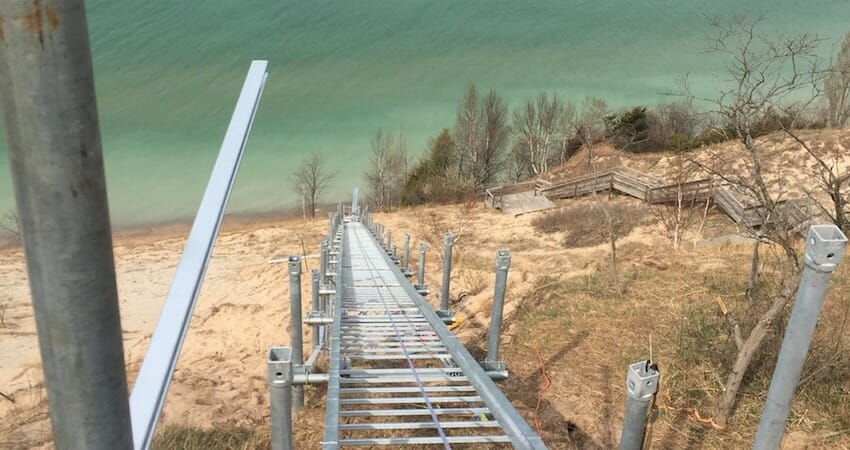
Thanks to the help of All Access Lift LLC, we were able to place the helical piers and transport all tram components up and down the sand dune. Once the helical piers were properly installed, we were able to complete the rest of the tram. Even though this project was challenging, we were able to complete all the requirements for a sturdy and safe way to enjoy beachfront property. The property owners can now enjoy an easy descent down to the waterfront using their new inclined tram. No more having to hike up and down 266 stairs! Kent Foundation Repair was able to provide an easy, structurally secure alternative to get to the waterfront quickly and easily.

